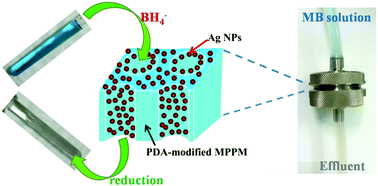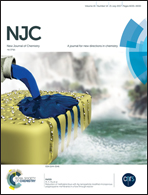Reduction of methylene blue with Ag nanoparticle-modified microporous polypropylene membranes in a flow-through reactor†
Abstract
Metal nanoparticles exhibit high catalytic activity in catalytic reactions due to their large surface area and abundant exposed coordination sites. Immobilization of metal nanoparticles provides an efficient method to increase the chemical stability and mechanical strength of the metal nanoparticles. Compared with the free metal nanoparticles, the immobilized metal nanoparticles are particularly suitable as they can be recycled and used in the flow-through systems. Polymeric membranes with high specific surface area are suitable carrier materials to immobilize nanoparticles. In this study, Ag nanoparticals (AgNPs) were uniformly immobilized on the surface of microporous polypropylene membranes (MPPMs) via in situ reduction of Ag+ by the polydopamine (PDA) layer adhered on the membrane surfaces. FT-IR/ATR was used to characterize the chemical structure of MPPMs after modification. SEM and EDX mapping images were obtained to characterize the distribution and stability of the AgNPs on the membranes. The amount of immobilized AgNPs is directly linked to the skin layer of PDA on the membranes. The AgNP-immobilized membranes showed high catalytic activity for methylene blue (MB) reduction with NaBH4. The dye solution quickly and completely discolored as the MB solution flowed past the AgNP-immobilized MPPM. Ethanol is a good cleaning and wetting agent to regenerate the AgNP-immobilized membranes and improve the catalytic activity of the membranes. The flow rate and residence time together define the catalytic efficiency. The flow-through membrane reactor had the best performance when the flow rate was greater than 210 L m−2 h−1 (the residence time was only 2 s). These results reveal the promising potential large-scale applications of the AgNP-immobilized membranes for dye removal and wastewater treatment.



 Please wait while we load your content...
Please wait while we load your content...